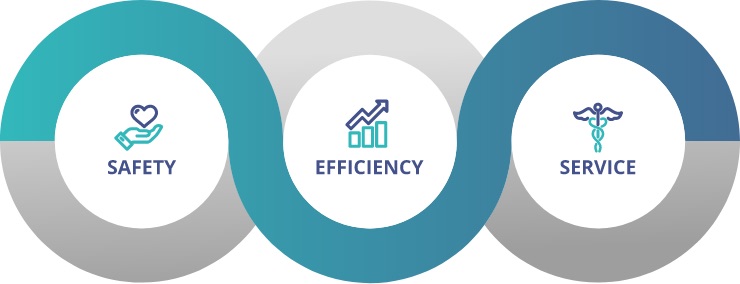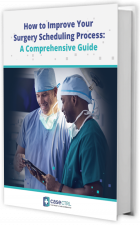How to Improve Your Surgery Scheduling Process: A Comprehensive Guide
In this guide, we’ll cover ways to improve your practice's surgery scheduling in order to improve OR efficiency, clear more cases, and better cope with the fluctuations in patient loads. Read the guide below or enter your email to download your copy to take on the go.
Introduction
Did you know that the average physician spends over 15 hours per week on paperwork, and a surgeon needs to communicate a minimum of 150 data points for one surgery to be accurately scheduled? The cumbersome, laborious, and error-prone surgical scheduling process is causing surgeons to leave an average of $500k on the table every year.
The OR scheduling process is all too often stuck in the past, running in a silo from the rest of the hospital or ASC systems and too reliant on single schedulers to carry the organizational burden. This leads to stressed and overworked surgeons in urgent need of a better way to communicate their complex surgical plans and timelines, while the scheduler has to organize a complicated interdependent list of resources needed for this very important task.
The good news is that it doesn’t have to be that way.
Using a robust surgery scheduling solution to get the right information to the right parties is the key to orchestrating a successful surgery cost-efficiently. From recording supplies needed and communicating with insurance companies to coordinating anesthesiologists and getting clearance from other medical professionals — you need a trackable and measurable process to manage the complex workflows.
When it comes to surgery scheduling, efficiency can make all the difference in improving patient outcomes and satisfaction—not to mention boosting revenue. With many practices forced to make administrative cuts, the burden on healthcare practices and ASCs to streamline surgery scheduling is even greater than ever.
How are modern ASCs taking a smarter approach to surgery scheduling? In this guide, we’ll explore the most common challenges to surgery scheduling, how to maximize the efficiency for your OR, and how having an electronic scheduler can alleviate some of the common obstacles to smooth surgery scheduling.
Table of Contents
Chapter 1. An Overview of Surgery Scheduling

To understand the surgery scheduling process, it’s important to look at what challenges exist to efficient scheduling. Do you know what the biggest threat to operating room efficiency is? It probably comes as no surprise to learn that squandered time from outdated or inaccurate surgery scheduling processes tops the list.
Your practice likely coordinates multiple surgery types with a small support staff. Together, you are entering hundreds of data points per patient, juggling many stakeholders, and managing inevitable reschedules and cancellations, all under increased scrutiny for patient satisfaction and outcomes from payers.
So, it’s not a stretch to see how many things can slip through the cracks.
Biggest Surgery Scheduling Challenges
When challenges to the surgery process go neglected, they compound, further disrupting the process. For example, the negative outcomes can include:
Stressed surgeons due to over/under-booked blocks, progressively later start times throughout the day and miscommunication with patients
Stressed staff from working overtime or feeling blamed for a surgeon schedule that goes awry
Disgruntled patients because of long wait times and inaccurate procedure information or billing
It’s wise to understand more about the underlying surgery scheduling problems so that you can effectively evaluate how software solutions address them.
Here are six common areas where scheduling gets derailed and how you can take back control.
1. Surgery Scheduling Entry Inaccuracy — If your ASC or hospital uses codes to classify surgeries, there may be codes that are consistently misused. This error can lead to inaccurate billing, time variations, and poorly coordinated days where the most similar surgeries should have been grouped together. The problem could be that schedulers have to glean which procedure is necessary by conversations, handwritten notes, or clumsy manual-entry procedures.
2. Inadequate Procedural Descriptions — Look at the descriptions and how well they are matching the realities in the OR. Is there a standardized way to make a surgery entry more specific – i.e., anesthesia plan, recovery instructions, etc.? Tighter procedural descriptions and details mean less work for the surgeon to recite or enter data and less work for the scheduler to decode notes. These gaps will otherwise add up, and it may be neither the surgeon nor the scheduler’s fault, although both will feel the impact.
3. Surgery Time Estimates — Often, surgeons provide estimates for surgery time in their own way. Whatever the means, schedulers need to be able to enter the room-in to room-out based on the other factors in the particular surgery. Certainly, there are other efficiencies to address, but the first step is to understand the baseline for current surgery time estimates.
4. All Cross-trained and No Specialized Staff — Your ASC or hospital likely has a cross-trained staff of nurses and assistants; after all, ASCs can save payers thousands per procedure by doing less with more. But, strategic specialization on complex or unique procedures can pay off in efficiency. Know which assistants work most effectively on which procedures to shave time off difficult-to-monitor details such as room preparation or draping. Look for ways to have specialized assistants where it makes the biggest difference. Surgeons can be invaluable resources in this effort. If you have a staff that is cross-trained, identify which staff members are most effective in a given surgery and give them more time in those places on the schedule.
5. Communication Confusion — Chronically inadequate communication will show up in the surgeon schedule. It is well documented in medical literature since the 1960s that patient communication positively affects patient recall, patient understanding, and patient adherence to therapy. To keep patient communication effective, follow these guidelines:
- Keep it simple
- Be specific
- Use some repetition
- Minimize jargon
- Check patient understanding
One way to confirm understanding is to use automated channels to communicate standard messages to the patient before and after seeing the surgeon. Some software subscription services can help schedulers maintain contact with patients throughout the process.
6. Drowning in Paperwork — There cannot be an emphasis on authentic communication and efficiency if physicians or schedulers are performing rote and redundant data exchange and entry. More time on paperwork equals more errors. These are avoidable errors, considering that over 90% of patients’ surgeries are formulaic. Fortunately, software programs allow data to be consolidated and to the extent possible and for forms to be auto-filled with predictable entries.
Once you’ve identified, possible challenges to the surgery scheduling process, it’s time to look toward best practices that can aid in a more efficient process.
Surgery Scheduling Best Practices
Surgery scheduling involves everyone at your ambulatory surgery center – from the practice administrator to surgeons, to the patients you serve. However, numerous barriers can prevent your ASC or your hospital from accurately and efficiently scheduling surgical cases.
It takes a dedicated staff following best practices and using the best scheduling tools available to ensure that the surgery scheduling process goes smoothly.
Utilizing an electronic scheduler, here are seven best surgery scheduling practices that your ASC or hospital should follow.
Replace Paper-Based Scheduling — Often, schedulers are slowed down by old paper-based scheduling. This approach is not only time consuming for the scheduler, but also prevents practice administrators and surgeons from easily accessing the information they need to manage and prepare for the whole surgery process. Moreover, schedulers cannot collaborate or share their work when scheduling information is siloed in paper posting forms. Eliminating paper-based scheduling can reduce the amount of time surgeons spend on filling out papers – freeing them to spend more time with patients and, ultimately, relieving them from being overworked and stressed.
Don’t Rely on Only One Scheduler — A scheduler may leave for a new job, or something may come up that keeps them out of the office for a day or two – but that shouldn’t mean that your surgery center falls behind on cases. Training new schedulers may mean that they’re not up to speed for several days or weeks. However, with surgery scheduling software that is aware of individual surgeon case preferences, you can train anyone on your staff to use the system, eliminating the risk for lost time, money, or mistakes being made in the process, and the friction of familiarizing a scheduler on a surgeon’s particular preferences for surgery.
Maintain Open Communication with Everyone on Staff — To prevent siloed processes and miscommunications between staff, surgeons must be able to communicate their schedules and needs efficiently – without overwhelming schedulers. With as many as 150 data points required for one patient’s surgery, mapping out all of the data successfully is an arduous task for even an experienced scheduler and surgeon. It can be difficult to keep track of and manage all of this data and communications for just one surgery, let alone dozens of others. Just consider that a surgery scheduler must not only consider space constraints and staffing requirements but also track any potential conflicts and equipment needs, while ensuring that the timeline is met. By using an electronic surgery scheduling system, surgeons and schedulers can more easily communicate about schedules, patient data, billing, and, most importantly, ensure that the OR environment puts patient safety first.
Reduce Surgery Cancellations — It’s vital to have an action plan when cancellations occur for any reason. Cancellations can happen due to a scheduling error – you may not have the staff required for the procedure at the right time. Or perhaps you don’t have the correct supplies ready on the day of surgery because of an oversight with ordering. Regardless of the reason, surgery scheduling software can help you to stay organized by enabling you to review surgery schedules in advance, supplies needed, and any potential conflicts for surgeons.
Avoid Lost Billing and Errors — Each year surgeons are losing approximately $500,000 in billing. With an electronic surgery scheduling system, you can ensure that your ASC or hospital is maximizing the number of cases you’re able to schedule. You can use surgery scheduling software to ensure that cases are being properly billed to insurance companies and patients, as well as have a clear overview of complex surgical billing information, so you can more easily find potential billing errors.
Prioritize the Patient Experience — An electronic surgery scheduling tool allows surgeons to effectively create customized cases for each patient, down to every detail, to ensure a successful surgery experience. For example, many patients have additional health conditions that surgeons must be aware of before surgery. To avoid this information becoming lost, it can be provided by the patient electronically and confirmed through surgery software.
Implementing proactive communication is another way surgery scheduling software is valuable, as you can set up reminder calls or texts that will provide crucial information for the day of surgery.
Utilize Data to Track, Measure, and Diagnose Potential Problems — By tracking and measuring this essential data, practice administrators and surgeons can proactively diagnose potential issues with surgery scheduling and then determine an action plan so that these issues won’t pop up again. Ultimately, surgery scheduling software offers a user-friendly way to track surgical candidates. It gives practice administrators the ability to control key processes, with insights into the data that matters the most to everyone involved – allowing you to review and take action when needed.
Guidelines for Successful Surgery Scheduling
ASCs are booming in general, offering affordable and efficient alternatives to hospitals. In fact, in an October 2020 Becker’s article, Jim Freund, senior partner at ASCs Inc., states, “We have truly seen a paradigm shift away from hospital-based procedures to the ASC setting, and Covid-19 has acted as yet another catalyst.” Unlike hospitals, ASCs have not been hamstrung by government mandates to preserve resources for coronavirus surges.
With more patient traffic comes the need to be even more intentional about surgery scheduling practices. Implement effective surgery scheduling guiding principles now to benefit from future market growth and streamline your workflow.
Here are five surgery scheduling guidelines to focus on as you improve your scheduling process for profitability—without sacrificing patient care.
- Empower Schedulers by Sharing Their Knowledge — Schedulers are juggling multiple issues for multiple physicians all of the time—five or more surgeries in a day for several different specialties. Equipment can be misdelivered, and redundant information sharing (backtracking to find manually compiled data) can muddle incoming details. Software solutions can give schedulers the power to do more, and it can also spread their knowledge to others who don’t have easy access to their information so that teams can work as a flexible unit—the essence of good surgical management.
- Improve Claims Success Rate — A scheduling process can be strengthened by automating all of the predictable elements of a case. Are you currently making sure to go through all the steps of patient pre-authorization? Is there a system monitoring the number of claims cleared over a given time? Rote aspects of client communication can be generated by an adjunct software program to lessen patient confusion about financial responsibility and provide resources when appropriate.
- Analyze the Blocks — Block scheduling helps physicians manage their time if they are adjusted to the emerging realities of the practice. Are you tracking the following key factors in scheduling blocks?
• Length of each surgery
• Lead time of patients
• Groupings of specialties and procedures
Effective scheduling systems give surgeons simple ways to analyze their utilization of blocks. Most ASC physicians have a vested interest in performing as many surgeries as possible. If you can monitor the specific administrative hurdles that affect their work, you may be able to help them free up time.
- Make Clear External Communication a Priority — Simple lapses in communication can derail otherwise refined surgical management.
Did You Know?
Schedulers should build in time to make sure the two parties can establish a shared understanding of the plan for each procedure. Cancelled surgeries can result from poor communication with the referring physician or the patients themselves. Many important messages to patients can be automated with software programs that manage candidates.
- Seal the Cracks— The final surgery scheduling guideline encompasses the small, but persistent ways that OR time disappears or goes unused, the cracks. Here are four factors you should consider:
Prospects: In the midst of cancellations and reschedules, schedulers can lose focus on prospects from referring physicians or those who have delayed an elective surgery for reasons which could have long passed. Schedulers can think of the need to have a Client Relationship Management or CRM-like system for tracking relationships with surgery candidates.
Turnover: Scheduling depends on accounting for consistent room and staff turnover between procedures. Once baselines are established for a given procedure, individual elements can be analyzed for their impact. Perhaps there is a lag in communication between departments—pre-op, OR, PACU. If it is taking too long to rearrange rooms, you may look back to blocking effectiveness, or perhaps a floating member of the staff can help better prepare the OR for turnover.
Admissions: Analyze the admissions protocol of your center to make sure there are no redundant or irrelevant tests taking place. This is also a place where patient education may reveal itself as inadequate.
Punctuality: Are supporting staff and physicians arriving in time to prepare for procedures? What about patients? Are mechanisms in place to confirm appropriate arrivals for patients on the day of surgery? Having people in place in one thing, but having information organized for them at the same time can be especially difficult.
Many of the threats to profitability ASCs point toward a need for improved efficiency through meeting surgery scheduling guidelines. A software solution that consolidates these scheduling processes in one place that is easy to access for all can ensure adherence to these guidelines. Next, let’s review some of the materials you’ll need to evaluate to make sure your surgery scheduling process is up to par.
Chapter 2. Surgical Preference Cards and Other Must Have Materials

Surgical preference cards serve as a valuable blueprint for surgical workflows and logistics. Surgical preference cards can be considered checkpoints between surgical inventory on one end, and the specific needs of surgeons or procedures on the other. However, their usefulness depends on how well they are managed.
When used and maintained properly, the cards encompass all the surgical needs of the procedure, providing a logical set of instructions for positioning, as well as what supplies, instruments, and equipment are required for a specific procedure by a specific physician. They are used to ensure that the right supplies are available when needed so that the medical personnel can prioritize patient care rather than the search for the right supplies, and, ultimately, eliminate waste while optimizing supply expenditures. The information on the preference cards helps with determining which operating room should be used.
Surgical Preference Card Management
Surgical preference cards play an essential part in achieving a more seamless surgery and enabling better documentation. A shift from written to electronic preference cards followed not long after the development of electronic health records. However, maintaining the cards and ensuring that their utilization is fully optimized can still be time-consuming and expensive.
Fail in this, and you have outdated or inaccurate preference cards that misrepresent the current needs of the surgeon and the resources available through the hospital. Such cards correlate to poor communication and an increased risk of errors in the operating room. Instead of being advantageous for the operating room, they become liabilities.
For example, outdated or inaccurate preference cards cause operating room door openings during a procedure because someone has to leave the operating room during a surgery to obtain the missing supplies/item. This interruption leads to a delay in the procedure, which leads to lost revenue for the surgeon and the hospital as well as an increased risk of infection to the patient.
Outdated preference cards can also result in the waste of incorrectly pulled equipment and supplies. This is concerning as high-cost physician preference items are included in the disposable or implantable items used in the operating room that make up 30 percent to 40 percent of a hospital’s supply expenses. In fact, they make up the largest percentage of inventory spend.
A Modern Solution for Surgical Preference Card Management
A surgical case management platform can empower all stakeholders of the operating room, including the surgeons, schedulers, and hospital administration. Look for a platform that integrates input from all the relevant stakeholders. You do not want the preference card to deteriorate into a laundry list of all surgical supplies the surgeon has ever asked for.
An effective platform will learn the surgeon’s preferences for each case type and variation and empower the team to understand when and what the surgeon may utilize for each individual case.
Preference cards should contain concise procedural instructions that, when combined with an accurate record of necessary supplies and equipment, prevent unnecessary delays and procedure disruptions. Using CaseCRTL allows you to transform your current preference card system from liability in the operating room to a valuable asset that dynamically responds to specific case needs for optimal performance and outcomes on the day of surgery.
Now that you understand how critical surgical preference cards can be, let’s take a look at how you can begin to get yours in order.
Cleaning Up Your Surgical Preference Cards
Keeping your surgical preference cards up-to-date helps ensure that all the necessary equipment is available at the start of a procedure to avoid delays. Having the right items at the ready also allows personnel involved in an operation to focus on the patient, rather than searching for supplies.
Accurate and up-to-date preference cards can also improve patient safety, achieve faster response time, improve turnover time, reduce the risk of complications, minimize anesthesia times, ensure the punctual start of procedures, avoid costly cancellations, and prevent waste caused by incorrectly pulled supplies.
Not to mention, accurate surgical preference cards can improve staff communication and collaboration, minimize frustration, and improve employee retention. They also help reinforce a culture of safety and increase operational cost-efficiency.
To start, audit your existing surgical preference cards. Your assessment should identify major issues, such as inefficiencies, miscommunications, or the inability to capture costs. You should also take inventory of how many cards you have and whether they’re paper, electronic, or both.

Remove cards associated with outdated procedures or inactive surgeons. Then, delete any extraneous information to keep the data as relevant and succinct as possible. Also, audit how often unused, opened instruments are getting returned so you can find ways to reduce wastes. Involve end users (e.g., surgeons and nurses) from the start to ensure buy-in and minimize revisions required in the future.

You can also analyze the differences among surgical preference cards from various physicians for the same procedures. Discuss your findings with the physicians to see if they can adjust their processes so you can create a more standardized approach. This can help you uncover cost-saving opportunities, consolidate the procurement of supplies, and improve efficiency.

The Challenges of Maintaining Accurate Surgical Preference Cards
Cleaning up your surgical preference cards is a key step, but even more important is to make sure they’re kept up-to-date. But as you can imagine, maintaining a large number of surgical preference cards, each corresponding to one specific procedure, is a daunting task.
Inefficiencies can be caused by relying on a limited number of staff members (e.g., overworked nurses and surgery calendar schedulers) to update or access the surgical preference cards. For instance, your preference cards are more likely to be subjected to human errors, and your ability to schedule operations promptly may be hindered by the schedulers’ availabilities.
Also, if you have paper or local digital copies of surgical preference cards kept by multiple schedulers or at different facilities, you need to make sure that every party receives a new version when an update is made.
Building a Cost-Efficient Surgical Preference Cards System
To maximize the benefits of surgical preference cards, you need an effective system that’ll allow you to streamline their cleanup, maintenance, and management; it’s for this reason that many practices choose surgery scheduling software to aid in the process. This will help you ensure the accurate and complete transfer of surgeon knowledge so that anyone can schedule a case to minimize reliance on a handful of employees and surgery calendar schedulers.
A centralized electronic database augmented by automation capabilities enables you to manage your surgical preference cards all in one place. It allows anyone involved in scheduling and performing the procedures to access the information in real-time.
A HIPAA-Compliant Intelligent Repository
Our AI-powered HIPAA-compliant intelligent repository not only provides a centralized location for all the preference card information but also learns each surgeon’s case preferences over time to reduce the dependence on surgery calendar schedulers.
The easy-to-use platform captures communications to make surgical preferences clear, consistent, but customized to each case, and easy to retrieve. No more second guessing what the surgeon may request for the case. You can leverage past data to clean up existing cards and real-time updates to ensure the most accurate data analytics. Another way that CaseCTRL’s platform helps is by automating and tracking business processes needed for essential surgery forms.
Essential Surgery Forms
Using the right surgery form, making sure they’re filled out correctly, and getting them to the right people at the right time without being bogged down by paperwork is essential to improving your practice’s profitability. What surgery forms do you need for scheduling and patient documentation and how can you ensure that they’re processed in an accurate and timely manner to promote a more efficient and safer OR or ASC?
Let’s examine the five most important forms, why they’re essential, and how you can streamline the procedures to improve your practice’s operational cost-efficiency.
1. Preauthorization Form — A preauthorization is a type of surgery scheduling form that is also called precertification, prior authorization, insurance verification, and prior approval. It allows you to verify the portion of the cost that a patient’s insurance policy will cover. Using these forms helps optimize the reimbursement available for your practice, ASC, or OR. It confirms the amount covered by insurers and patients’ responsibilities so you’ll more likely get paid. With tracking and automation, you can follow the progress of every preauthorization request and follow up appropriately to make sure that nothing falls through the cracks. In addition, the ability to automate the scheduling process as soon as a pre-authorization is approved keeps your pipeline moving.
2. Doctor Preference Card (DPCs) — Also called Physician Preference Lists, Procedure Cards, Resource Cards, Pick Lists, or simply Cards, DPCs helps you communicate your preferences to the OR or ASC staff so that the right supplies and equipment are available for each surgery. When only items needed for surgery are pulled and opened, it lowers cost and reduces waste. Also, you can improve operational cost-efficiency and treatment outcomes by ensuring that the right supplies, instruments, equipment, and medications are available at the right time. You can ensure that every OR and ASC is getting your most updated DPCs for every procedure before surgery by automating the process.
3. Patient Surgical Assessment Form — This form helps you collect information about a patient’s medical history and routine medication before surgery. Essentially, this form helps to ensure safe procedures. The information helps ensure that you aren’t performing procedures or using medications that contradict your patients’ current medical conditions or treatments. This can help prevent liability issues and ensure the best outcomes. Meanwhile, knowing how to contact the patients or their caregivers post-op allows you to follow up effectively. Tracking and automated routing ensure that every assessment form is submitted and reviewed by the right people before surgery to avoid contradictions. You can also set reminders to contact patients and their caregivers post-surgery to improve the patient experience.
4. Surgery Change Form — This form communicates procedure changes or cancellation of a scheduled surgery to the parties involved. The information helps you manage canceled and rescheduled surgical cases effectively. For example, by freeing up resources reserved for the surgery or following up with the patients to ensure that they’re getting the proper care. You can automate patient follow up to minimize the time your staff spends on contacting each person. This can help you effectively manage your pipeline so that no case falls through the cracks.
5. Miscellaneous Forms — Other forms that you’ll want to consider include a History and Physical Request Requirement form, Anesthesia Fact Sheet, Medication Reconciliation List, Patient Bill of Rights and any forms that communicate preoperative and postoperative appointments.
Essential Forms Checklist
To make your form collection process more efficient, you can use this checklist to make sure each item is handled for all surgeries.
- Surgery information sheet with Preauthorization Number
- Surgery consent form signed by the patient and the surgeon
- Signed informed consent forms for any special procedures with signatures of patient and surgeon
- Pre-operative instructions signed by the patient
- Patient Record Release signed by the patient
- Materials Request Form
- Operative Report Request Form
- History and physical request (requirements) given to the patient
- History and physical request sent to PCP
- History and physical (medical clearance) signed and dated by the primary care physician
- Specialty History form signed by surgeon
- Anesthesia Fact Sheet given to the patient
- Medication Reconciliation List given to the patient
- Work/School excuse note for surgery
- Patient bill of rights
- Preoperative and postoperative appointments with the surgeon
In essence, the more that you can automate and track essential forms, the better. It helps to cut down on manual processes and human error while also keeping the pipeline moving. With automation, you can help to promote compliance and cultivate a culture of proactive communication. This is only a glimpse of the ways that a surgery scheduling platform can benefit your practice. Read on to find out even more ways it can benefit your OR.
Chapter 3. Using Surgery Scheduling Software to Improve OR Efficiency

To achieve more efficient surgical scheduling, you may want to investigate what software options are available. To get started, let’s examine what you should expect from a robust, effective solution.
What Makes a Good Surgery Planning Software?
Not all surgery scheduling software is created equal, so evaluate your options thoroughly to choose a comprehensive service that covers your healthcare practice’s unique needs.
Here are the most important features to look for when choosing a surgery scheduling software:
Case Builder — A case builder should be available to allow surgeons to effortlessly build complex cases in seconds. Ideally this should be a point-of-care tool that reduces the occurrence of lost or illegible case posting sheets and clinic interruptions. This feature streamlines the case building process and a sophisticated version can incorporate intelligent learning algorithms, saved surgeon preferences, coding engine, and multi-location support.
Integrated Dashboard — Seamless collaboration is made easier by an integrated dashboard. An integrated dashboard tracks pending, scheduled, completed, held, and canceled surgical cases in one central location that anyone on the team can reference.
Intelligent Repository — This feature learns a surgeon’s case preferences to lessen your scheduler’s workload and time wasted trying to retrieve information. Communication within the software makes preferences clear and easy to retrieve. The repository references the case and shares information automatically, reducing surgeon dependency. Moreover, a centralized repository empowers anyone to help schedule surgery for a surgeon, reducing the need for a surgeon to spend hours training a scheduler their specific case preferences.
Surgical Calendar — Surgical calendars that come equipped with an intelligent operating room allocation tool using institutional, surgeon, patient, and case-specific scheduling requirements can optimize scheduling sequences. A calendar that helps teams maximize block time utilization increases surgery throughout. With an electronic solution updated in real time, everyone will be informed when changes are made, reducing scheduling confusion while saving time.
Automatic Notifications — Automatic notifications keep everyone on the same page sending alerts to patients, staff, surgeons, coordinators, assistants and anyone else involved in the surgery with a click of a button. Notifying patients, staff, and surgeons regularly can reduce tardiness, making sure surgeries start on time as much as possible. Plus, automatic notifications can be used to prepare patients for surgery. Practices save hours using the system to automatically solicit OR availability.
Risk Analyzer — You can curb cancellations with a risk analyzer, a decision support tool that takes care of analyzing patient and case-specific risk factors. Such a tool helps you identify patients who will benefit from specialist pre-operative clearance, cases at high risk for readmission and complications, order appropriate screening labs and highlight opportunities to proactively improve patient satisfaction. Using software to automate collection of patients clearances and labs can save the practice hours of grief later.
Patients Guides — Virtual patient guides allow you to communicate and form personal connections with patients without spending valuable staff hours. With this feature, you can automatically send push reminders, encouragement, and more to your patients. CaseCTRL features integrated AI chatbots that can answer common questions patients have specifically about their surgeries. This allows you to build patient trust, making them feel confident in their surgeon’s team and enhancing their overall experience.
Ease of Use — Like any product, if surgery scheduling software is not easy to use, then schedulers and surgeons will spend a lot of time working out how to do things, with less time to get the work done. The surgery process is complex enough without having to learn to use a complicated piece of software. Your OR scheduling tool should be intuitive to use with dashboards that all team members can easily interpret. It should also be customizable to take into account the nuances of surgery scheduling.
Cloud-Based — Look for HIPAA compliant software that runs on the cloud, also known as SaaS, or Software as a Service. Using a cloud-based tool reduces the need for having on-site technical knowledge or support. For example, with SaaS, you don’t need to worry about updating software or about keeping your data synchronized across different machines and sites. Running software in the cloud, rather than on premise, also means surgeons and schedulers can access data from anywhere on different devices.
With a number of OR scheduling solutions on the market, it can be hard to decide which ones will actually deliver value. Looking for these must-have features will help you identify markers of excellent surgery scheduling software.
Benefits of Operating Theatre Scheduling Software
Now that we’ve reviewed some of the most important features of surgery scheduling software, let’s examine the benefits and how it can be a game-changer for your practice.
Let’s face it, the daily scheduling of an operating theatre is a consistent act of juggling various criteria and competing objectives. Due to the high cost of running an OR, schedulers are under tremendous pressure to maximize the use of the facilities while balancing the quality of patient care.
Inefficient scheduling (which can be caused by a breakdown in communications between surgeons and schedulers on surgical plans, case times, and other requirements) can lead to costly idle time between cases, significant overtime costs, and increased patient anxiety because of delays or rescheduling of surgery.
From surgeons estimating case time for each surgery to schedulers selecting the correct procedures, organizing all the resources, and communicating the schedule back to the surgeons accurately, many things can go wrong along the manual process.
With as many as 150 data points in one surgery, it’s a challenge to orchestrate the multiple parties involved, manage staff requirements, as well as track potential conflicts and equipment needs so that you can ensure that the timeline is met. Moreover, without transparency earlier in the scheduling process, it is very hard for schedulers and groups to pool and cooperatively optimize unused operating room time, often until it’s too late.
Reliance on manual estimation and a handful of independent schedulers reduces the efficiency and accuracy of these processes. Not to mention, it’s cumbersome to manually update everyone on schedule changes, yet failing to get all the personnel, tools, and supplies lined up can create a negative ripple effect on treatment outcomes, while also leading to costly delays, cancellations, and diminished patient satisfaction.
Here’s why the use of operating theatre scheduling software is on the rise and how it can benefit your practice:
Clear communication between surgeon and scheduler helps eliminate misunderstanding and ensures that the right personnel, supplies, and resources are set up correctly.

A cloud-based platform allows everyone involved to get real-time updates to minimize errors and delays caused by schedule changes.

Algorithms analyze similar surgeries and provide accurate case time estimation to help maximize resource usage without impacting patient experience.

Effective coordination among the various specialists involved helps facilitate cross-disciplinary collaboration to improve treatment outcomes.

The ability to better manage cancelled surgeries allows you to prioritize and organize action items so that you can follow up and reschedule cases efficiently.

Increase visibility into your scheduling workflows enables you to stay in control and diagnose issues in the pipeline quickly.

Better visibility earlier in the scheduling process, across the practice, fosters sharing of under-utilized operating room resources.

Better planning and resource allocation reduce the costly problem of having to line up excess capacity to accommodate unpredictable circumstances.

We have investigated even more ways that a software solution will streamline your process and give your practice a competitive edge.
8 Ways to Improve Operating Room Efficiency
From minimizing operating room costs to creating an easier scheduling process to maintaining open communication with staff, discover these eight ways you can improve operating room efficiency.
1. Minimize Operating Room Costs — Ideally, hospitals and ASCs would utilize as few operating rooms as possible in order to minimize costs. In part, this comes down to schedulers who have the understanding that even if an OR is available, it might be more efficient to schedule cases in preexisting underutilized operating rooms. In addition, hospitals and ASCs may also need to take additional precautions related to COVID-19, which may require a limited number of surgical cases to be scheduled each day to allow for ample time for proper disinfection protocols.
Using a surgery scheduling platform, ASCs and hospitals can review their operating room schedule electronically to determine if every surgery has been scheduled correctly with the appropriate patient data points, surgeon, staff, time block, and equipment.
2. Use a Digital Operating Room Schedule Board — With a digital operating room schedule board, an administrator or scheduler can easily update changes in one place with surgery scheduling software. This feature allows the information to update anywhere that the digital operating room schedule board is displayed in the hospital or ASC. This visibility will provide surgeons and staff with a clear view of the day’s schedule, allowing them to see vital information and foresee any potential issues that may prevent them from using operating rooms efficiently.
3. Create an Easier Surgery Scheduling Process — An automated surgery scheduling system is not only faster, but it allows hospitals and ASCs to see where there might be missing elements before the day of surgery, such as patient information, staff, equipment, or insufficient time blocks for the surgical case. By catching issues early, you can make the most efficient use of operating rooms.
4. Track Surgeon Utilization — If a surgeon is not using all of their scheduled block times, schedulers or administrators can determine if the surgeon may take on additional surgical cases. On the other hand, surgeons may use all of their time blocks but run short on time for some surgical cases. This conflict may require an adjustment to the operating room schedule, ultimately leading to inefficiencies. Ideally, administrators and schedulers can track utilization through surgery software to determine how well surgeons are utilizing their time blocks.
5. Avoid Equipment Issues — Broken, missing, or simply unavailable equipment causes major issues for operating room efficiency, leading to delays or even cancellations the day of surgery. For example, if two operating rooms are scheduled for the same time that requires the same equipment, it’s likely that one surgery will have to be delayed or cancelled depending on patient, surgeon, and staff schedules. To prevent these issues, surgeons and staff should utilize a surgery management platform to document the necessary equipment for each surgical case as well as flag broken or missing equipment so that any issues can be handled in advance of the scheduled surgery.
6. Prevent Delayed Start Times — Start time is of particular importance as a delayed surgery can impact cases throughout the rest of the day. To prevent start time issues, schedulers can utilize surgery scheduling software to ensure that the patient, surgeon, and staff are aware of the start time and that they are notified in advance to be early in order to prepare. Another consideration for schedulers is that a case may take more or less than the time scheduled in the operating room. To improve operating room efficiency and scheduling, the most predictable cases should be scheduled earlier, allowing more time for surgeries that may need more time. By doing so, administrators can more likely avoid time crunches.
7. Maintain Open Communication with Staff — Whether you hold weekly team meetings to share vital information about any issues that arise or ask for staff to document and communicate problems within your surgery scheduling platform, it’s important that any feedback is turned into action. By simply meeting to voice concerns, issues, and ideas, your team can make changes to daily processes that will improve operating room efficiency.
8. Ensure That Patients Are Prepared for Surgery — While your hospital or ASC can manage everything from operating room schedules to equipment to staff, if a patient is unprepared, this may derail even the best-laid plans. A surgery scheduling platform can indicate if there are missing elements before the day of surgery. Verify that any lab work has been completed, all necessary patient information added to the system, and make sure that the patient has been notified of anything they might need to do before surgery as well as surgery start time and when they should arrive.
Chapter 4. The Future of Surgery Scheduling

Having an electronic scheduler can alleviate some of the common obstacles to smooth surgery scheduling. Let’s review how the rise of the electronic scheduler is changing how practices increase OR efficiency.
Appointment scheduling systems allow for timely access to health services. With all the complexities involved in surgery scheduling, it is probably no surprise that a number of companies have jumped to the forefront to provide cutting edge, high-tech, cloud-based solutions to the market that are revolutionizing the process. Many of the processes used for surgery scheduling are archaic and human resource intensive. Just like travel agents once used to make complex flight plans, we envision a fully digital and consumer facing surgical scheduling process that allows staff to focus on delivering optimal surgical care.
Still, knowing how to schedule surgery is as much an art as it is a science, and despite the fact that advanced technology such as artificial intelligence (AI) is incorporated into newer surgery management solutions, many aspects of the surgical scheduling process still rely on the skill and intuition of the scheduler, so it’s important that both of these considerations are taken into account.
Surgery Scheduling Considerations

To effectively schedule surgery, consider three important patient outcomes: safety, efficiency, and service. Of course, surgical schedulers must make decisions based on clinical needs as the safety of the patients is paramount. To schedule surgery safely, thorough consideration must be given to infection control, patient and preoperative preparation, and practical considerations like the length of time needed to perform the surgery, and how each time period impacts all the other procedures in the pipeline.
A well-designed scheduling tool can help maximize the efficient use of your operating room and surgical resources. These tools help schedulers understand their priorities and reduce the amount of time to schedule cases to help your practice operate safely, profitably, and efficiently.
Exploring Solutions
Providing a user-friendly way to track surgical candidates, resources, hundreds of data points, and automate the numerous repetitive tasks requires technological sophistication—as well as insider knowledge of the industry. Designed by an orthopedic surgeon, CaseCTRL’s scheduling software acts as an intelligent repository that automates important parts of the scheduling function so that practices are no longer dependent on one person. The use of electronic schedulers lessens your risk for lost time and lost revenue.
Using an integrated dashboard, your scheduler can move faster while ensuring accuracy with AI-enabled patient guides, and automated reminders, and an intuitive interface that can analyze case-specific risk factors.
Choosing the Right Surgery Scheduling App
Did You Know?
A 2016 estimate showed that the U.S. healthcare system loses $150 billion to missed patient clinic appointments. The same report revealed that patients miss between 5 and 30 percent of appointments, each costing about $200 or more.
The impact of no-shows for surgeries is order of magnitudes higher as surgeries have more variables — the surgeons, helping staff, operating room, and other costs. A study by Tulane University revealed on average one missed surgery can cost upwards of $7100.
The Tulane study found that patient no-shows were a common cause of cancellations, with 30% of patients failing to show up on the day of surgery due to transportation issues, uncertainty regarding the date of the procedure, or simply forgetting about the appointment. The same study found that nearly one-third of Tulane’s cancellations stemmed from issues at the hospital, like a lack of available equipment.
Surgery Scheduling Challenges
Hospital administrators apply scheduling systems to allocate surgery resources — the OR to assign, surgeons’ requests, the staff to assist, and the patients to book for surgery. This is a complex process since the hospital must account for the following:
Cost — A fully-staffed OR costs about $1,000 per hour to run. ORs should only be open when they are in use or else the hospital loses money.
Surgeons’ requests — Hospitals must do their best to honor surgeons’ time-slot requests.
Interruptions — The unpredictability of the hospital environment throws time schedules into disarray, and the impacts can ripple to cause even more losses.
It is also difficult to predict when surgery requests will come and how long certain surgeries will take, but hospitals must still find ways to accommodate these uncertainties. Surgery scheduling apps can go a long way in limiting the losses caused by inefficient or unpredictable patient scheduling and management.
If you’re looking for a surgery scheduling app, there are many qualities to evaluate, not just its price. The same vetting process should be carried out for free apps as for premium-rate apps, as these qualities contribute to patient safety and the security of their information.
Features for the Ideal Surgery Scheduling App
Learn the qualities to look for in your ideal surgery scheduling app below.
HIPAA Compliance
The Health Insurance Policy and Accountability Act was passed in 1996 to protect and keep private individuals’ medical records and personal health information (PHI). All healthcare providers, as well as healthcare-related mobile and web apps, must be HIPAA-compliant according to the Act.
It goes without saying that all healthcare-related software that deals with protected patient health information must be HIPAA compliant. But what you might not be aware of are the risks inherent to using free versions of Google Calendar. Entering PHI into Google Calendar is not permitted unless specific HIPAA requirements have been met. You’d need to upgrade to the paid version of Google, have a Business Associate agreement with Google on file, and properly configure all account settings to avoid unnecessary risk. Working with a HIPAA-compliant app is a much smarter way to secure protected information.
Patients expect their information will be protected and there are large fines and consequences for not adhering to HIPAA regulations. Moreover, any software you are considering for surgical scheduling must uphold the strictest security standards stipulated by the Act. No EHR will be willing to integrate or share data with a non-compliant app.
Seamless EHR Integration
The Electronic Health Records (EHR) system that you use is the foundation of an effective and efficient surgery scheduling app. The EHR system partnered with the app should be stable, user-friendly, intuitive, and easy to customize and update.
When looking for a surgery scheduling app, review the EHR integrations the platform allows. If you already have an EHR, you need an app that integrates with it without extensive customization. Seamless EHR integration enables patient information sharing/updates to improve patient experience, manage their communication, process payments, and anticipate any complications occasioned by details in the patient’s history. Most EHRs have adopted the FHIR/HL7 communication standards for interoperability. Make sure the surgery scheduling software you use has an application programming interface (API) compatible with this common standard.
Scheduling Protocol Automation
The purpose of surgery scheduling apps is to automate most of the administrative/management processes related to appointment booking and procedure scheduling. Healthcare automation through powerful AI-driven algorithms is the future of all surgery scheduling software.
Most vendors claim that they have scheduling automation, but often this doesn’t extend beyond surface level, which can mean that your patients and staff end up having to do more work.
These three simple questions can help you to distinguish true automation from shallow automation:
How much time does the software consume for the staff to register a patient for surgery?
Is the application integrated into your workflow, operating in the background, but also available to help you find relevant information?
What tasks can your software accomplish independently? Your ideal app should be able to initiate, run, and terminate tasks with no human intervention.
Leveraging AI can help with decision intelligence, which is often where human intervention is needed most.
Integrated Dashboards
Integration refers to the way two software solutions work together. Surgery scheduling apps are often integrated with EHR systems and healthcare management systems.
With the right integrations, your front office staff doesn’t have to constantly update the practice management software with changes from the app. This, in turn, saves time and effort. What’s more, the integration can reduce patient wait times, increase access, and improve customer satisfaction.
Surgical Calendars
Applying AI and automation can help optimize surgical calendars, which involve a classic case of merging patient needs, level of priority, and resource availability. One of the most common challenges surgical facilities face is efficiently managing surgeons underutilized block time. Block time is a surgeon’s set hours available in the operating room. A good scheduling software will identify opportunities to maximize the surgical throughput to help surgeons with unused block time share under-utilized hours with their peers.
AI-Enabled Patient Communication
Finally, low-level patient communications should be easily managed by an AI-driven chat bot or voice assistant to free up staff time for more important tasks.
For example, a patient may message a scheduler to delay a surgery. A surgery scheduling application should be able to readily handle this common request. Frictionless mechanisms to allow patients to propose new times for surgery or automated tools to follow up with patients not ready to finalize a date are essential. An assistant then can easily confirm the desired time slot or suggest other open slots for the patient to pick from.
Similarly, if an interruption or delay originates in the surgeon’s office, the AI assistant can take over appointment rescheduling and inform the patients. Your app should be able to handle much of this without human intervention.
The Future of Surgery Scheduling
Healthcare automation and AI in healthcare is the future — and that future is here. When looking for a surgery scheduling app, you need a robust and intuitive yet user-friendly solution. Such an app can be used by both patients and non-technical staff with ease. Think about your practice in its entirety and use the above qualities to shortlist solutions that will truly help your business.
Conclusion
If you are looking for a way to improve your ASC’s scheduling in order to improve OR efficiency, clear more cases, and better cope with the fluctuations in patient loads, now is a great time to retool.
CaseCTRL’s software was built by surgeons for surgeons to effectively manage the entire surgery scheduling process and support surgery centers. CaseCTRL also integrates a point of care tool called Case Builder that allows surgeons in clinic to create and communicate complex cases with ease.
Our technology uses a HIPAA-compliant Intelligent Repository to store case preferences for each individual surgeon, taking away any guesswork of the surgeon’s preferences and ensuring that the information is circulated among the appropriate parties. The artificially intelligent system manages the surgeon’s preferences and evolves as the surgeon interacts with the system.
A Saas platform, CaseCTRL’s software can manage the entire surgical case pipeline and can integrate with your existing ASC or hospital EMR. Most importantly, this software enables shared data that is easily accessible and extracted for analysis.
Contact CaseCTRL to schedule a free demo and learn how to empower schedulers to work and share more efficiently while physicians can spend more time with patients. Less paperwork, redundancy, confusion, and stress means a more profitable ASC.


